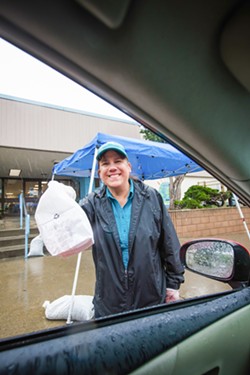An untimely recess
Local schools work to provide meals and classes amid coronavirus closures
By Kasey Bubnash[{
"name": "Ad - Medium Rectangle CC01 - 300x250",
"id": "AdMediumRectangleCC01300x250",
"class": "inlineCenter",
"insertPoint": "8",
"component": "2963441",
"requiredCountToDisplay": "12"
},{
"name": "Ad - Medium Rectangle LC01 - 300x250",
"id": "AdMediumRectangleCC01300x250",
"class": "inlineCenter",
"insertPoint": "18",
"component": "2963441",
"requiredCountToDisplay": "22"
},{
"name": "Ad - Medium Rectangle LC09 - 300x250",
"id": "AdMediumRectangleLC09300x250",
"class": "inlineCenter",
"insertPoint": "28",
"component": "3252660",
"requiredCountToDisplay": "32"
}]
The afternoon of March 13 was an ominous one, as one after another, public schools and colleges across San Luis Obispo County announced plans to close down for weeks to come. Classrooms will be shuttered for at least the last two weeks of March and some until mid-April, a countywide effort to prevent a coronavirus outbreak locally.
The closures will have drastic impacts on students and families throughout the county, especially those who earn low wages, can't work from home, or have young children. That's partly why the countywide school closure is a prevention strategy the SLO County Public Health Department didn't recommend.
Just hours before the SLO County Office of Education announced its endorsement of the temporary school closures on March 13, Public Health Director Penny Borenstein said at an 11:15 a.m. press conference that such stringent action wouldn't yet be necessary in SLO County.
"The reason for being very judicious and cautious about canceling school is obvious to most," Borenstein said at the briefing, where the Public Health Department declared a local health emergency because of the coronavirus pandemic. "That is a huge societal disruption. And this epidemic, this pandemic, is sparing children so far."
Despite some pushback from audience members and online commenters, who shared concerns about children carrying COVID-19 and spreading it to at-risk populations, Borenstein stood by her recommendation.
"It is not without repercussions to shut down society as we know it," she told the audience.
Now with local schools closed, providing students with meals, access to online and special needs curriculum, and ensuring funding are the most pressing priorities for local educators.
SLO resident Berry Worden has a freshman at SLO High School and a fifth grader at Hawthorne Elementary School. Worden, who works remotely regularly, said the closure won't be too challenging for his family, but as president of Hawthorne's PTA, he's aware that his situation is unique.
"I imagine my inbox is going to be stacking up here pretty quick," Worden told New Times on March 13.
Most other parents he knows, including his wife, work jobs that simply can't be done at home. If those parents have young children who can't be left alone, he said that's a big problem. And a lot of local families rely on the free and reduced meals provided by schools.
Still, Worden said he's confident that the closure is what's best for the health of the community.
"Is it inconvenient? Yes," Worden said. "Let's work together and we'll be able to get through this."
Albeit, he said, with "some bumps and bruises."
Local schools are doing their best to lessen the blow. A little more than 13,150 of SLO County's K-12 students were eligible for free and reduced school meals during the 2018-19 school year, according to data compiled by the California Department of Education. Most local school districts have set up meal pickup programs that will be available throughout the coronavirus closures.
In the San Luis Coastal Unified School District, which will be closed until April 15, all kids ages 0 to 18 will be able to pick up two free meals at 10 different sites from 11 a.m. to 1 p.m. every weekday. A child must be present to get a meal, but sign-in information won't be required. Other SLO County school districts are providing similar grab-and-go programs.
Administrators and faculty throughout the county are also working to develop online courses to keep students sharp throughout the unexpected break. But that could be a difficulty for students without computers or Internet access. In the San Luis Coastal district, parents in need can apply to receive a district-provided mobile device and Internet hotspot for free.
School districts are providing all these services through their usual budgets, according to Sheldon Smith, assistant superintendent of business services for the SLO County Office of Education.
"I don't anticipate any extra expense," Smith told New Times. "I do anticipate shifted expenses."
In the weeks leading up to the local school closures, there were some worries that schools might lose state funding if they shut down because of the coronavirus.
Schools receive funding in part based on average daily attendance and instructional minutes. If a school doesn't meet its minimum number of instructional minutes or its average daily attendance declines, it could lose significant funding. In the event of an unplanned decline in attendance that's out of a school's control—typically something like a snowstorm—schools can apply for a J-13A waiver, which, if approved by the California Department of Education, allows schools to get funding as usual for those low attendance or instructional days.
It's unclear whether schools will have to use J-13A for the coronavirus closures, but Smith said an executive order issued by Gov. Gavin Newsom on March 13 ensures that California schools will receive their usual funding throughout the coronavirus-related closures.
"At this point, it reinforces the flexibility of school districts to close without having the fiscal aspects make their decisions for them," he said. Δ
Staff Writer Kasey Bubnash can be reached at [email protected].
Latest in News
Comments
Showing 1-1 of 1
Readers also liked…
-

Coast Unified teachers upset over new position's salary and qualifications
Oct 20, 2022 -

SLO police identify alleged driver who hit and killed couple
Dec 22, 2022 -

When the levee breaks: Oceano residents, county officials walk a tightrope of regulations to manage Arroyo Grande Creek, which some say led to the levee's failure in January
May 18, 2023










